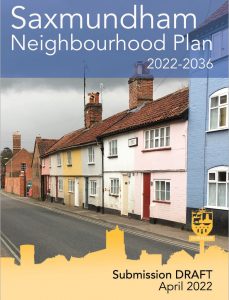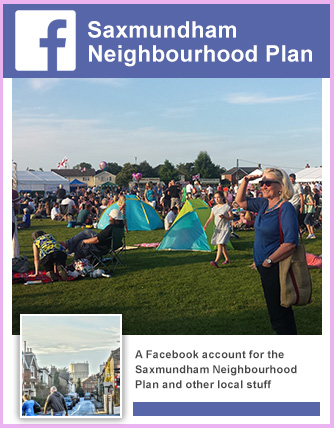At last – Neighbourhood Plan submitted – our final version after consultation
Tuesday, June 7th, 2022 4:47 pmSaxmundham’s Neighbourhood Plan has – finally! – been submitted to East Suffolk Council in late May. It is attached here – REDUCED SIZE Saxmundham NP Submission v9 (2)
The Plan covers the period 2022 to 2036 (in line with the district council’s Local Plan timescale). This second draft includes a significant number of (mainly smaller) changes which come from comments made on the first draft, in response to our major public consultation. That took place in November and December last year, and included a public exhibition at the Market Hall. In all, around 100 written responses and comments were received, some of them detailed. The NP Steering Group and Town Council thank all those who took part. In general terms, the Plan was well received and its main policy direction had a lot of support.
The process now is briefly as follows: The local planning authority (East Suffolk Council) now carries out its own consultation, in particular of those who made written responses to the first draft. It also appoints an independent examiner who checks the Plan for compliance with all the legal requirements; the examiner may also make suggestions for changes to improve the drafting. Once this is complete, and any final amendments agreed, the ‘final final’ Plan is put to a local referendum of voters in Saxmundham. If a simple majority of those voting are in favour, the Neighbourhood Plan is adopted by East Suffolk Council.
What is new when the Plan is adopted?
This has two major consequences – the Plan’s policies become an integral part of the planning policies (alongside those in the district council’s Local Plan) used to decide on all planning applications relating to Saxmundham. Second, once the Plan is adopted, the town receives 25% of all Community Infrastructure Levy (CIL) funding paid by developers for new buildings – instead of the present 15%. This neighbourhood CIL funding (which goes to the Town Council) can be used in the parish to create new physical or social infrastructure to meet the town’s needs arising from new development and growth.
Some main changes in the Plan

REDUCED SIZE Saxmundham NP Submission v9 (2)
As stated above, we made a significant number of changes to the first draft to respond to points made – often very usefully – to the first draft, in the public consultation process.
We had, in preparing the first draft, received very helpful advice and proposals from our technical consultants, AECOM, who drew up indicative ‘masterplans’ for the proposed new Garden Neighbourhood and for improving the Town Centre area, and also for Design Guidelines for the Garden Neighbourhood and parish as a whole. The new version of the Plan makes clear that AECOM’s reports are not binding, but provide useful guidance.
The new Garden Neighbourhood is a product of the district council’s Local Plan, not of Saxmundham’s Neighbourhood Plan as such – but our NP is not allowed, by law, to override a policy set in the Local Plan, so we have sought to ensure that it works as well as possible both for new residents and for the existing town, if it is to proceed. In particular, as the only road access will be on to the A12, we need to ensure that foot and cycle connections are as good as they can be, to prevent the new development being effectively cut off from the town. This is reflected in new wording in paragraph 1.12, which also re-confirms that the new Neighbourhood is to be delivered by a masterplan approach “through landowner collaboration and community engagement” (n.b. there has been no community engagement for nearly 18 months now).
We have redrafted the Objective for the new Neighbourhood to refer also to Garden City principles:
“To create a high quality, well designed, distinctive new development in line with ‘Garden City’ principles which is valued by its residents and recognised as an asset to the Town.”
In relation to the town’s local economy, we have made a small but important change in the Objective 1 (page 36) to include the words “forward looking” – to reflect the fact that we want to attract new and modern forms of economic activity, such as the renewable energy and cultural and digital industries, in addition to retail and more traditional service sectors:
“Objective 1: To promote a strong and diverse forward looking local economy, building upon the town’s advantages as a service centre market town with a strategic location”.
We also now give more emphasis to the role of arts/cultural and related industries in the text, e.g. page 49 “Support is given for a range of potential employment sectors including those relating to retail, hospitality and creative and cultural industries such as those already resident at The Art Station.” See also text on policy SAX3 on “new businesses”.
The Policy on Design Principles (SAX1) has been amended (page 45), to improve the overall drafting, and to leave out direct references to the AECOM Design Guidelines and Codes. It also gives more emphasis to supporting “Proposals that incorporate eco-friendly, innovative or contemporary designs whilst respecting the architectural heritage and character of the area”, and cross-refers to the separate section on the town’s Conservation Area.
We have, in response also to comments, somewhat redrafted the chapter previously called “Community, social and recreational provision”, now renamed Community Infrastructure”. The purpose is to be more explicit on what projects we would hope to use Community Infrastructure Levy (CIL) funding, including potential partnership with the district council on jointly supported initiatives.
In particular, we have redrafted Policy SAX5 on New community facilities (see page 55) which now defines as “essential infrastructure”:
(a) Fully functioning indoor sport and leisure provision, and (b) a fuller range of local health services, for example, new or expanded health and social care facilities.
Under “Desirable Infrastructure” we now list (a)Entertainment and cultural facilities, (b) Improved social provision, particularly for the young and the socially isolated.
In the earlier draft Plan, The Layers was listed (Policy SAX16) among the Local Green Spaces. The new draft now defines The Layers as ‘Suitable Alternative Natural Greenspace’ (SANG), as part of the Garden Neighbourhood, which we consider is a better definition.
Among smaller changes in the policies relating to the new Garden Neighbourhood, we have now included a reference in SAXGN1 to Public Transport – “The site access will need to be able to accommodate buses to easily serve the site including bus linkages to the town centre and supermarket area. New bus stops should be provided within easily accessible locations.”
Close readers (!) of the new version of the Plan will note that we have renamed what were called “Site specific policies” as “Opportunity Zones”, to avoid suggesting that we were allocating specific sites for specific land use policies. Instead, we indicate what sort of developments the Town Council would be minded to support, but without actually earmarking them definitely. To allocate sites would have added new legal complexities and would have further delayed the process for getting the Plan finalised.
Thank you’s
A few final words from Jeremy Smith, Chair of the Steering Group…
We started out in 2017, 5 long years ago, with the aim of drawing up Saxmundham’s Neighbourhood Plan. The whole process was delayed by the need to respond first to the Local Plan put forward by Suffolk Coastal District Council (later becoming East Suffolk Council), which introduced the 800 dwelling Garden Neighbourhood policy, and later on by the COVID pandemic. The NP process has indeed also become, over the years, over-bureaucratic and too technically complex. It is vital that there is a strong “bottom up” dimension to local planning, but surely the powers-that-be don’t need to make it so horribly complicated!
Though its membership has changed a little over 5 years, the Saxmundham Neighbourhood Plan Steering Group team have stuck to the task heroically, and the Town Council does thank everyone involved most warmly. In recent months, the team has comprised Christine Buttery, Steve Palmer, Lyn Jardine, and Councillors John Findlay, Di Eastman, and Tim Lock, plus John Fisher (also district councillor) as permanent observer, with Jen Morcom clerking the Group with efficiency.
Also many thanks to our excellent planning advisers, including technical support from AECOM at a key period, and in particular in recent times to Andrea Long and Rachel Leggett. And finally, huge thanks to the residents of Saxmundham who have given your time and made your contributions, in substantial numbers, at all stages of our consultations.
BACK TO NEWS
